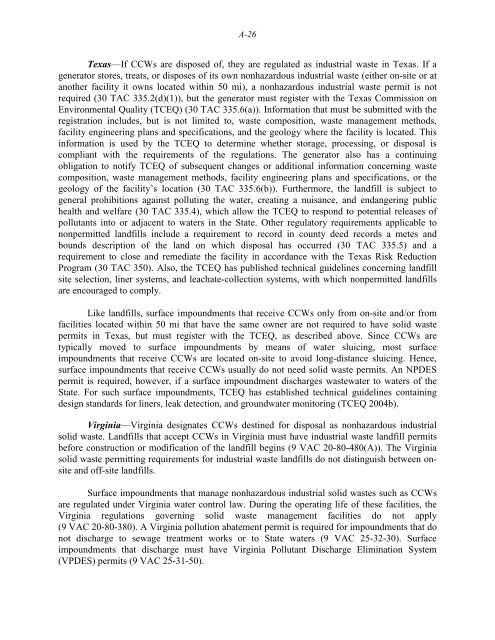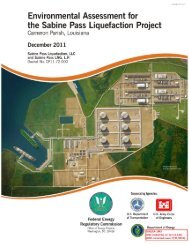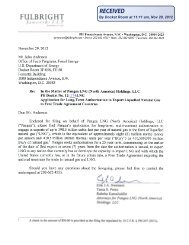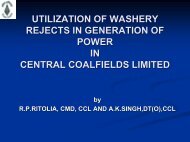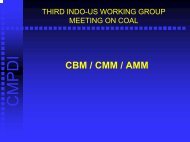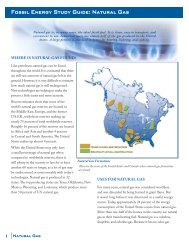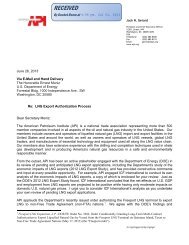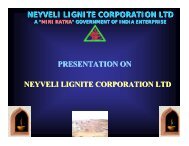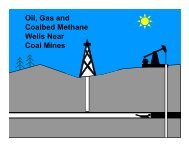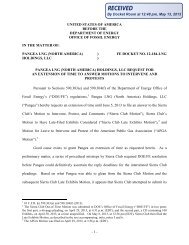Coal Combustion Waste Management at - DOE - Fossil Energy ...
Coal Combustion Waste Management at - DOE - Fossil Energy ...
Coal Combustion Waste Management at - DOE - Fossil Energy ...
Create successful ePaper yourself
Turn your PDF publications into a flip-book with our unique Google optimized e-Paper software.
A-26<br />
Texas—If CCWs are disposed of, they are regul<strong>at</strong>ed as industrial waste in Texas. If a<br />
gener<strong>at</strong>or stores, tre<strong>at</strong>s, or disposes of its own nonhazardous industrial waste (either on-site or <strong>at</strong><br />
another facility it owns loc<strong>at</strong>ed within 50 mi), a nonhazardous industrial waste permit is not<br />
required (30 TAC 335.2(d)(1)), but the gener<strong>at</strong>or must register with the Texas Commission on<br />
Environmental Quality (TCEQ) (30 TAC 335.6(a)). Inform<strong>at</strong>ion th<strong>at</strong> must be submitted with the<br />
registr<strong>at</strong>ion includes, but is not limited to, waste composition, waste management methods,<br />
facility engineering plans and specific<strong>at</strong>ions, and the geology where the facility is loc<strong>at</strong>ed. This<br />
inform<strong>at</strong>ion is used by the TCEQ to determine whether storage, processing, or disposal is<br />
compliant with the requirements of the regul<strong>at</strong>ions. The gener<strong>at</strong>or also has a continuing<br />
oblig<strong>at</strong>ion to notify TCEQ of subsequent changes or additional inform<strong>at</strong>ion concerning waste<br />
composition, waste management methods, facility engineering plans and specific<strong>at</strong>ions, or the<br />
geology of the facility’s loc<strong>at</strong>ion (30 TAC 335.6(b)). Furthermore, the landfill is subject to<br />
general prohibitions against polluting the w<strong>at</strong>er, cre<strong>at</strong>ing a nuisance, and endangering public<br />
health and welfare (30 TAC 335.4), which allow the TCEQ to respond to potential releases of<br />
pollutants into or adjacent to w<strong>at</strong>ers in the St<strong>at</strong>e. Other regul<strong>at</strong>ory requirements applicable to<br />
nonpermitted landfills include a requirement to record in county deed records a metes and<br />
bounds description of the land on which disposal has occurred (30 TAC 335.5) and a<br />
requirement to close and remedi<strong>at</strong>e the facility in accordance with the Texas Risk Reduction<br />
Program (30 TAC 350). Also, the TCEQ has published technical guidelines concerning landfill<br />
site selection, liner systems, and leach<strong>at</strong>e-collection systems, with which nonpermitted landfills<br />
are encouraged to comply.<br />
Like landfills, surface impoundments th<strong>at</strong> receive CCWs only from on-site and/or from<br />
facilities loc<strong>at</strong>ed within 50 mi th<strong>at</strong> have the same owner are not required to have solid waste<br />
permits in Texas, but must register with the TCEQ, as described above. Since CCWs are<br />
typically moved to surface impoundments by means of w<strong>at</strong>er sluicing, most surface<br />
impoundments th<strong>at</strong> receive CCWs are loc<strong>at</strong>ed on-site to avoid long-distance sluicing. Hence,<br />
surface impoundments th<strong>at</strong> receive CCWs usually do not need solid waste permits. An NPDES<br />
permit is required, however, if a surface impoundment discharges wastew<strong>at</strong>er to w<strong>at</strong>ers of the<br />
St<strong>at</strong>e. For such surface impoundments, TCEQ has established technical guidelines containing<br />
design standards for liners, leak detection, and groundw<strong>at</strong>er monitoring (TCEQ 2004b).<br />
Virginia—Virginia design<strong>at</strong>es CCWs destined for disposal as nonhazardous industrial<br />
solid waste. Landfills th<strong>at</strong> accept CCWs in Virginia must have industrial waste landfill permits<br />
before construction or modific<strong>at</strong>ion of the landfill begins (9 VAC 20-80-480(A)). The Virginia<br />
solid waste permitting requirements for industrial waste landfills do not distinguish between onsite<br />
and off-site landfills.<br />
Surface impoundments th<strong>at</strong> manage nonhazardous industrial solid wastes such as CCWs<br />
are regul<strong>at</strong>ed under Virginia w<strong>at</strong>er control law. During the oper<strong>at</strong>ing life of these facilities, the<br />
Virginia regul<strong>at</strong>ions governing solid waste management facilities do not apply<br />
(9 VAC 20-80-380). A Virginia pollution ab<strong>at</strong>ement permit is required for impoundments th<strong>at</strong> do<br />
not discharge to sewage tre<strong>at</strong>ment works or to St<strong>at</strong>e w<strong>at</strong>ers (9 VAC 25-32-30). Surface<br />
impoundments th<strong>at</strong> discharge must have Virginia Pollutant Discharge Elimin<strong>at</strong>ion System<br />
(VPDES) permits (9 VAC 25-31-50).


